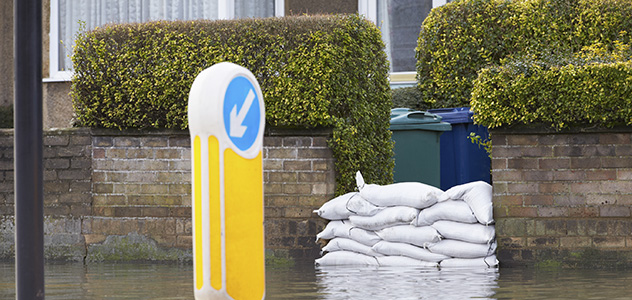Surface water flooding set to increase sharply, putting the success of Flood Re into question

The Flood Re insurance scheme will fail to reduce flood risk and the number of London households eligible for the scheme could increase by up to 75% during its lifespan, according to a paper published today (Monday 8 February) by the Grantham Research Institute on Climate Change and the Environment and the ESRC Centre for Climate Change Economics and Policy at London School of Economics and Political Science.
The authors of the paper – Katie Jenkins (University of Oxford), Swenja Surminski (LSE), Jim Hall (University of Oxford) and Florence Crick (LSE) – find that climate change and a high demand for housing are likely to lead to a sharp increase in the number of properties at risk from surface water flooding. These findings are based on a study of the London Borough of Camden and are applicable to rest the Greater London.
Whilst properties built after 2009 will not be eligible for Flood Re, the construction of new homes is expected to increase flood risk for older homes that are eligible for the scheme. As new homes are built, the permeability of the land is reduced and the likelihood of surface runoff increases.
The findings come ahead of the Flood Re transition plan, due to be published on Thursday 11 February, which will outline how subsidies for flood insurance in high risk areas will be gradually phased out.
The paper uses a simulation model to highlight the increasing pressure on flood insurance from surface water flood risk. It states that “as house prices rise so does the investment in new developments, often in high flood risk areas, and consequently overall flood risk rises.”
The authors also warn that the Flood Re scheme will not shift the behaviour of those groups that will determine future risk levels: homeowners, national and local governments, developers and insurance companies.
They conclude that it would be a missed opportunity if Flood Re was not redesigned to incentivise greater resilience to flooding.
The paper states: “This analysis suggests further policy on planning developments, increased investment in SUDS [sustainable urban drainage systems] for new and existing properties, and investment in PLPMs [property-level protection measures] is required. The forthcoming Flood Re scheme could help with this transition if it were able to incentivise such measures. These issues are likely to become more apparent under climate change and urbanisation and need to be considered within the framework if areas like Camden are to become more resilient to surface water flood events in the future.”
For more information about this media release, and to obtain copies of ‘Assessing surface water flood risk and management strategies under future climate change: an agent-based model approach’, please contact Ben Parfitt b.parfitt@lse.ac.uk, or Bob Ward r.e.ward@lse.ac.uk.
NOTES FOR EDITORS
1. The Grantham Research Institute on Climate Change and the Environment (https://www.lse.ac.uk/grantham) was launched at the London School of Economics and Political Science in October 2008. It is funded by The Grantham Foundation for the Protection of the Environment (https://www.granthamfoundation.org/).
2. The ESRC Centre for Climate Change Economics and Policy (https://www.cccep.ac.uk/) is hosted by the University of Leeds and the London School of Economics and Political Science. It is funded by the UK Economic and Social Research Council (https://www.esrc.ac.uk/). The Centre’s mission is to advance public and private action on climate change through rigorous, innovative research.
3. This research was carried out in partnership with the Environmental Change Institute at the University of Oxford. It is part of the EU FP7 project ENHANCE (Enhancing risk management partnerships for catastrophic natural disasters in Europe), funded under the Seventh Framework Programme of the European Union (grant agreement No 308438) (https://www.enhanceproject.eu).

